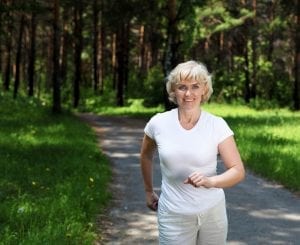 The benefits of walking for 30 minutes a day go way beyond just improving fitness.
The benefits of walking for 30 minutes a day go way beyond just improving fitness.
It’s a fact known and accepted by most that fresh air and exercise are good for us, but why 30 minutes?
The U.S. Department of Health and Human Services recommends that to experience the health benefits of exercise, we need to do a minimum of 150 minutes and up to 300 minutes of moderately intense aerobic activity per week.
Thirty minutes five days a week is a perfect starting point, and walking is ideal.
It’s something we already know how to do, so there’s no learning curve. You can go at your own pace, you can do it just about anywhere, and it’s easy to incorporate into daily life.
It doesn’t require any specialized equipment, either. Casual clothing and a comfortable pair of walking shoes are all you will need.
The mental health benefits of walking are just as substantial as the physical benefits of walking. And they can be experienced by walking for half an hour a day or less!
So there’s no reason not to make a conscious effort to go outside and get those legs moving!
You don’t have to stop at 30 minutes if you don’t want to.
For more significant benefits, including faster weight loss, extend your walking time to 45 minutes or an hour.
Alternatively, do two 30-minute sessions a day.
Table of Contents
How to start walking
If you lead a sedentary lifestyle, walking will enable you to ease into a routine and become healthier all around.
If you are very out of shape, it may take you several weeks or even longer to be able to walk for half an hour without stopping.
Start at a slow, steady pace for 10 or 15 minutes if that’s all you can manage. Increase your speed and the time you spend walking as your fitness improves.
How to fit walking into your day
Most of us are busy, and many of us work outside the home. Using these as excuses for being inactive really doesn’t cut it.
If you live reasonably close to your place of employment, try walking to or from work. This will enable you to reap the benefits and save on transportation costs.
Over time, if desired, you can walk both to work and back home.
If you work further afield, pack your sneakers and go for a walk during your lunch break.
Need help staying motivated? If so, see if a colleague would like to join you.
Having company can make the walks more enjoyable, and you will be less likely to look for excuses to skip them as you won’t want to let your work buddy down.
If you don’t have the time to walk during your lunch break, take your dog for a morning or evening walk or both.
Your pup’s enthusiasm will be contagious, and you will quickly look forward to your walks as much as your furry friend does.
If you don’t have a dog, offer to walk a neighbor’s pooch.
Mental Health Benefits of Walking for 30 Minutes a Day
Apart from the physical aspect, walking has been proven to positively affect the nervous system, reducing negative feelings of anger and hostility.
It gives us time to think and clear our minds. Moreover, it aids concentration and stimulates creativity.
A 2014 study published in the Journal of Experimental Psychology, Learning, Memory, and Cognition involved participants undertaking creative-thinking tests while seated and walking.
The result was that those who took part thought more creatively when walking than sitting.
Exercise, such as walking, boosts energy levels and improves mood. It helps us to remain more alert and energetic throughout the day and avoid that mid-afternoon slump.
Undertaking regular exercise, such as walking, is a great way to curb stress, too.
It lowers cortisol levels so that you feel more relaxed. It also releases chemicals into the brain, which are essential for maintaining good mental health.
And the Vitamin D that we absorb from the sun’s ultraviolet rays helps ward off depression and keep us feeling happy.
Research has shown that walking is an excellent antidote to overcoming depression and feelings of sadness.
A Duke University Medical Center study concluded that walking three times a week can manage depression symptoms as effectively as anti-depressant medications.
While exercising indoors on a treadmill is beneficial, walking outdoors was found to decrease the symptoms of depression further.
NB: When using sunscreen, your body can’t absorb vitamin D. However, frequent, prolonged unprotected exposure to the sun will put you at risk of developing skin cancer.
For this reason, it’s wise to limit your time in direct sunlight to between 10 and 15 minutes two to three times a week.
If you spend more time than this outdoors, be sure to apply a high-SPF sunscreen.
If you are on anti-depressants, don’t stop taking them without checking with your doctor.
Physical Health Benefits
A sedentary lifestyle can leave us susceptible to illness.
Regular aerobic activity, such as walking, strengthens the immune system.  You will be less prone to developing allergies and less likely to catch colds with a stronger immune system.
You will be less prone to developing allergies and less likely to catch colds with a stronger immune system.
One of the significant benefits of walking for 30 minutes a day is that it dramatically reduces the risk of chronic disease.
The gentle action of walking can reduce blood pressure, lower the risk of cardiovascular disease by as much as 30%, and reduce the incidence of a stroke attack by up to 40%.
Additionally, walking improves blood circulation, which is crucial for maintaining overall health.
Walking for half an hour a day can reduce bad cholesterol (LDL) and increase good cholesterol (HDL).
A half-hour daily walk can also lower blood sugar levels and decrease the likelihood of developing diseases such as diabetes, asthma, lung disease, and even some forms of cancer, including those of the breast, uterus, and colon.
A 20-minute walk fifteen to twenty minutes after eating can help if you have gastrointestinal issues. It will enable the food you eat to be processed faster and may lower the incidence of bloating.
For women, one of the primary benefits of walking for 30 minutes a day is that it can help to alleviate PMS symptoms. These include stomach cramps and discomfort, bloating, and mood swings.
Walking can ease menopausal symptoms in older women, including stress, daytime fatigue, and insomnia.
A daily walk stimulates bone formation and strengthens bones. This benefits seniors, especially women, for whom osteoporosis can be a problem later in life.
That’s not to say you are immune if you are a male. Men are also at risk as they age.
Our venous system includes a circulatory system called the “second heart” that pushes blood to the heart and lungs from the muscles, veins, and valves in our feet.
This system ramps up as we walk. Blood flow is boosted, and the leg muscles become stronger, decreasing the likelihood of varicose and spider veins developing.
If you already have varicose veins, a daily walk can reduce the associated swelling and leg restlessness.
Research has shown that 1 in 14 people over 65, and 1 in 6 older than 80, have dementia. A brisk 30-minute daily walk can avert brain tissue loss, help to preserve memory, and reduce your risk of dementia by around 40%.
Walking for half an hour a day can help manage chronic pain and enable you to sleep better and longer. Regular walks also have a protective effect against arthritis.
And if you need any more convincing to lace up your walking shoes and hit the streets, regular walks can delay the aging process and may even extend your life by as much as seven years.
According to an article published in Live Science, walking briskly for as little as 75 minutes a week can increase your life expectancy, even if you are overweight or obese.
Fitness Benefits
Walking regularly will improve your balance, flexibility, range of motion, and cardiovascular endurance.
It will tone and strengthen your leg and buttocks muscles, enabling you to achieve a leaner, tighter-looking figure.
It also tones the abdominal muscles. And if you swing your arms, they will also get a workout.
Another of the benefits of walking for half an hour a day is that it can help you lose or maintain your current weight.
An easy way to  burn calories, walking requires less effort, and you will sweat less than when doing more intense exercise.
burn calories, walking requires less effort, and you will sweat less than when doing more intense exercise.
Promoting a healthy heart through walking boosts the metabolism, enabling you to burn more calories and lose weight more easily. You won’t have to power walk or walk up steep hills to lose weight, either!
Walking to the supermarket or a friend’s house rather than driving will burn calories.
Naturally, the faster and further you walk and the more varied terrain on your route, the more muscles you will work and the greater the number of calories you will burn.
One 12-week study followed 20 obese women. Ten walked at 50-60% of their VO(2)max for 50 to 70 minutes at a time, three times a week. The other ten maintained their sedentary lifestyle.
The walkers lost an average of 1.5% of their body fat and reduced their waistline measurement by 1.1″.
The inactive group did not lose body fat, and their waistline measurements did not change.
Final Thoughts on the Health Benefits of Walking for 30 Minutes a Day
Fewer people are choosing to walk outside these days. Most of us prefer to drive or use public transport to save time and arrive at our destination faster. This reflects the fast-paced world we live in. We are becoming increasingly focused on technology and the digital world rather than the outside, physical one.
More and more jobs require us to sit inside at computers all day, tapping away and staring at a screen. It’s no wonder that mental illness has skyrocketed, affecting people from all walks of life.
Obesity rates are higher than ever, and cardiovascular risks are still very high, despite medical advances.
The health benefits of walking for 30 minutes a day are huge, and incorporating this simple activity into your daily life will significantly improve your mental and physical well-being.
Walking for exercise also enables you to get fit on a budget, so give it a try; you’ve nothing to lose besides your excess pounds.
Click here to read an article on the benefits of walking 10,000 steps a day.
Prefer to exercise indoors? If so, be sure to read this article on the benefits of treadmill exercise Vs. walking, jogging, & running outdoors.

